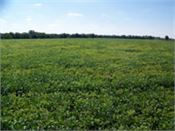Potash Pays Off

Potash-deficient crops will show yellowing along leaf edges.
Photo courtesy of Pat Miller.
NEVADA, MO.
Potash prices have risen about 75 percent in the past year, according to USDA Agricultural Marketing Service data. This has prompted many producers to cut back on applications. But that could be a mistake.
Potash is essential to healthy fields and pastures, says University of Missouri Extension agronomy specialist Pat Miller.
It is important to apply potash to replenish depleted nutrients.
“Potash-deficient fields are not going to yield their full potential,” Miller says.
Potash deficiency shows as yellowing along the leaf edges, a symptom that is sometimes confused with soybean cyst nematode.
Different crops deplete soils of potash at different rates, but all crops remove potash. Corn yielding 120 bushels per acre removes 35 pounds of potash per acre, while 45-bushel-per-acre soybean removes 65 pounds of potash.
If you apply potash only before corn in a corn-soybean rotation, you would have to apply 100 pounds of potash just to replace what was removed, says Miller. “If the soil needed potash to be built up or yields were higher, even more would be needed,” she says.
Pastures and hayfields also need potash. Harvesting 3 tons of fescue hay removes 100 pounds of potash. “So it is not surprising to find old hayfields that are nearly depleted of available potash,” Miller says.
Know your soil fertility needs. Take a soil test and follow recommendations. Contact the MU Extension agronomist in your area for more information.
Learn how to take and submit soil tests to the MU Soil and Plant
Testing Laboratory at soilplantlab.missouri.edu. ∆